|
From a distance boletes
look much like “regular mushrooms” that you buy in a grocery store. Unlike them, boletes have a spongelike layer
beneath the cap with many tiny holes called pores; these pores are the mouths of minute tubes where the spores are produced.
In that way they are like the polypores, but there the resemblance ends. Whereas the polypores are normally hard and woody
the boletes are soft and fleshy and rot quickly. The boletes are the largest family of edible mushrooms in North America;
however this is not a licence to eat all boletes that you may find in the woods. There are boletes that are inedible, bitter
or poisonous. Formerly most boletes were classified as Boletus or Suillus but are now split into as many as nineteen genera. I have listed thirteen of them
below. I have omitted other genera because some are almost exclusively Western species and others have only one or two
species and have never been reported from Nova Scotia. Most people however will probably come across much fewer genera
while out in the woods. The common term "bolete" encompasses ALL the genera in Boletaceae
not just boletus. The most common genera that you are likely to encounter in Nova Scotia are, Leccinum, Suillus,
Boletus, Tylopilus and to a much lesser extent Boletellus, Gyrodon and Chalciporus.
Boletus.
When many people think
about boletes they usually think about the King Bolete, Boletus edulis, since it is prized above all others for its delicious
nutty flavour.If you are seeking out B.edulis it is handy to know that Amanita muscaria can be found growing in the same locale
and can in many cases foretell the coming of the "Kings".See the pictures below.
Also pictured below is Boletus
subvelutipes which has red tube mouths and stains blue very quickly after cutting. This species is poisonous and should therefore
be avoided.
|
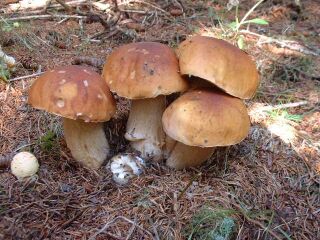
|
| King Bolete,Boletus edulis. |
A fine group of Kings Boletes. Note the Amanita muscaria button in the lower left of the picture.
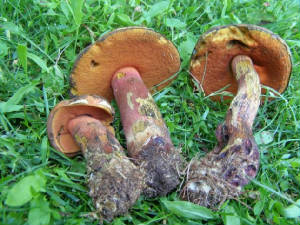
|
| Boletus subvelutipes. |
|
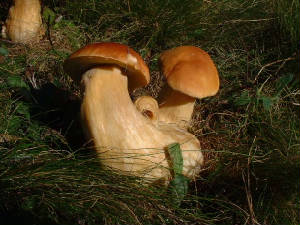
|
| King Bolete,Boletus edulis. |
Sometimes they develop a rather large bulbous base. The base is sometimes several times the size of the
cap.
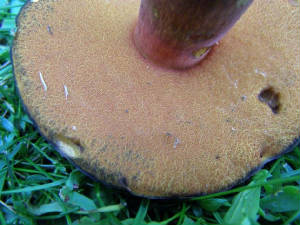
|
| Boletus subvelutipes. |
|
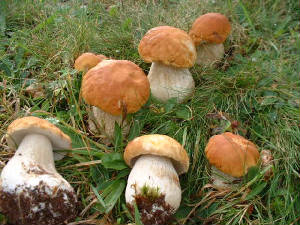
|
| King Bolete,Boletus edulis. |
Sometimes they decide to grow in groups which makes it very convenient for gathering purposes.
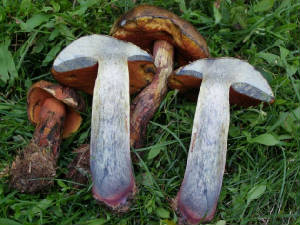
|
| Boletus subvelutipes. |
|
| |
|
|
Boletellus.
I have found only two species
in the genus Boletellus, those being B.chrysenteroides and B.russellii which was in such a bad state of decay
it was not worthy of a photograph. Spore print for B. russelli is dark brown and for B. chrysenteroides it is olive brown.
Chalciporus.
This is a small genus
containing only five species in North America and only one of those five commonly occurs in Nova Scotia, C.piperatus, formerly
known as Boletus piperatus. Its common name is peppery bolete. Spore print is reddish-brown See pics below.
Gyrodon.
In the genus Gyrodon
the chances of finding more than one species in northern North America are zero. There are a total
of four species known from North America and three of them grow in much warmer climes, those areas being Florida ,Texas, California
and in to South America. The only example of Gyrodon that you will find is G.merulioides, which has a fascinating relationship
with the Ash tree. Although it appears to have an association with ash trees, G.
merulioides is not mycorrhizal. Rather, it has a symbiotic relationship with Meliarhizophagos fraxinifolii, the leafcurl ash aphid. The mushroom
mycelium strands bunch together and form what is known as sclerotia which
are about 2-3mm in diameter, this then surrounds and protects the aphid. In exchange
for this protection the aphid's honeydew provides nutrients to the fungus. The Ash tree on the other hand receives no known
benefit from this mutually beneficial arrangement between the aphid and the mushroom. In
the pictures below you can see the off centre stalk and the attachment to the substrate. Also shown are the pores which
are slightly decurrent on the short stalk.
See pics below.
|
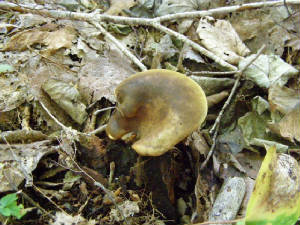
|
| Ash tree bolete,Gyrodon merulioides. |
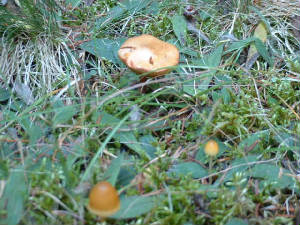
|
| Chalciporus piperatus,Peppery Bolete. |
|
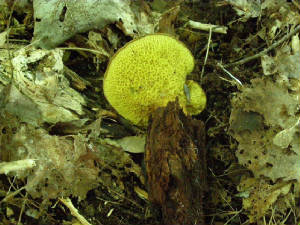
|
| Ash tree bolete,Gyrodon merulioides. |
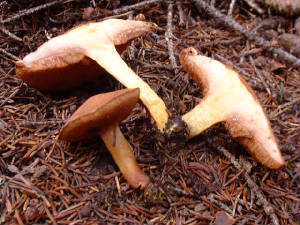
|
| Chalciporus piperatus,Peppery Bolete. |
|
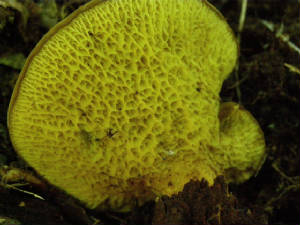
|
| Ash tree bolete, Gyrodon merulioides. |
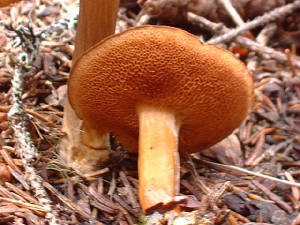
|
| Chalciporus piperatus,Peppery Bolete. |
|
| |
|
|
Mycology, the study of mushrooms, is a relatively new science that is still undergoing many changes and revisions. None
more so than when it comes to placing various species in their appropriate genus. Not so many years ago there were only
two genera of boletes, they being Boletus and Suillus. Depending on whether you belonged to the "splitters" or the "lumpers"
decided in to which genus you would place the species that you had under consideration.
Many different characteristics are used to separate one bolete genus from another, with some genera being more easily
recognisable than others. In this web page we are concerned with genera that can be recognised using field
characteristics. The colour of the spore print is always important.The shape and arrangement of the pores can also be helpful.
The colour of the pores in various stages of development is also an important diagnostic tool. Whether the mushroom changes
colour(stains) after cutting and noting the change is important. Staining blue or bluey green is common.
The two genera that are the easiest to recognise are Suillus and Leccinum. Mushrooms in the genus Leccinum
are commonly called scaber stalks because of the dark scurfy tufts of material attached to the stalks. The example shown below
is of Leccinum scabrum, commonly called the Birch bolete because of it's mycorrhizal association mainly with birch trees.
There are approximately 100 species of Leccinum in North America.
|
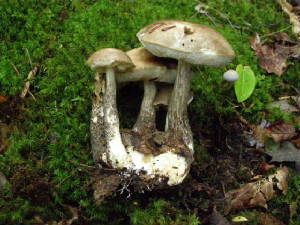
|
| Leccinum scabrum,Birch bolete. |
|
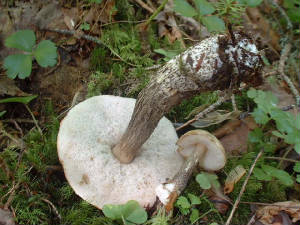
|
| Leccinum scabrum, Birch bolete. |
|
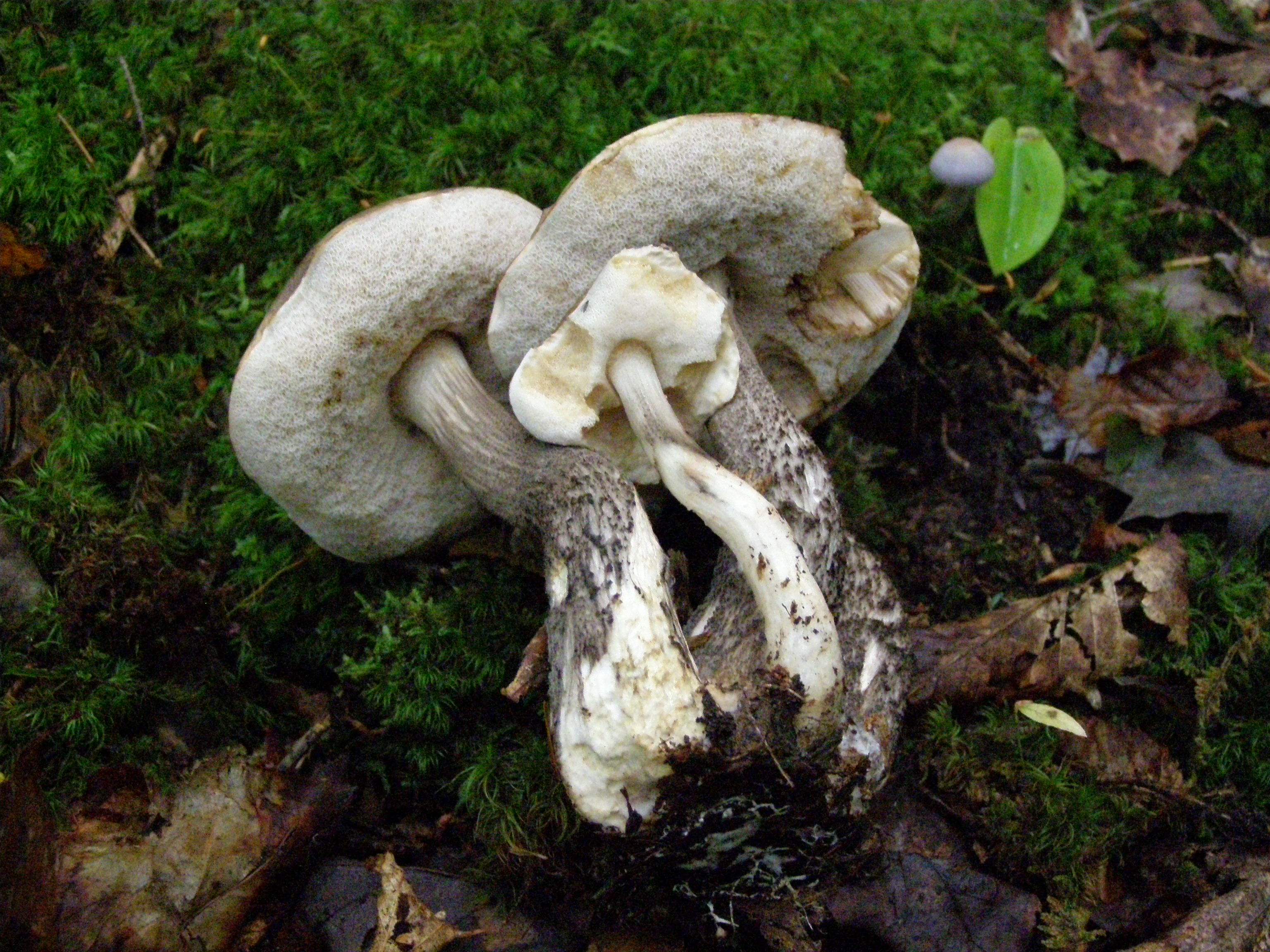
|
| Leccinum scabrum, Birch bolete. |
|
Suillus.
The genus Suillus is fairly easy to recognise with the most distinctive feature being the glandular dots that are present
on the stalk,see photo below of Suillus granulatus . A partial veil or annulus is also sometimes present. In
many species the cap surface may be sticky or tacky. The pores are more or less aligned radially, somewhat like the spokes
of a bicycle in that they radiate from the centre out to the margin (periphery) of the mushroom. They also form
a mycorrhizal association with conifers particularly pine. There are approximately 100 species of Suillus in North America.
See pics below.
|
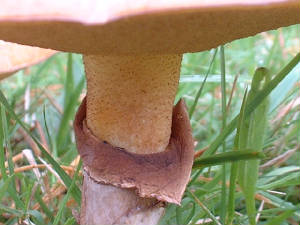
|
| Suillus luteus,Slippery jack. |
|
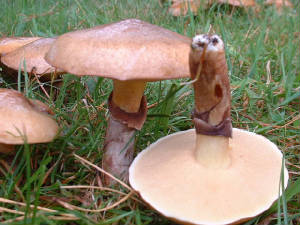
|
| Suillus luteus,Slippery jack. |
|
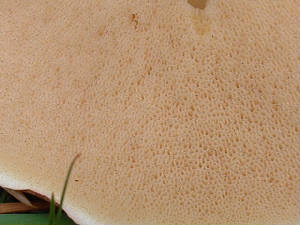
|
| Suillus luteus,Slippery jack. |
|
|
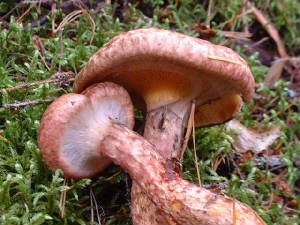
|
| Suillus pictus,Painted suillus. |
|
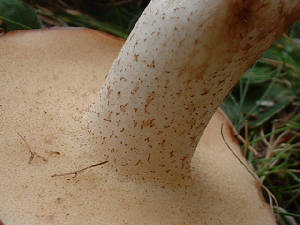
|
| Suillus granulatus,Dotted Stalk Suillus. |
|
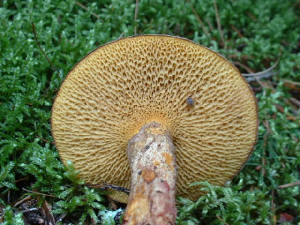
|
| Suillus pictus,Painted suillus. |
|
Tylopilus.
This then brings me to the genus Tylopilus. The mushrooms in this genus have a typical "bolete look" about them. There
is an old adage that if a bolete stains blue when cut OR has red tube mouths then it should not be eaten. This rule holds
true most of the time so therefore should not be relied upon for assessing edibility. An example that
I will give that disproves this is Tylopilus eximius (see pics below) which I find with some frequency.
T. eximius does not have red tube mouths and neither does it stain blue after cutting. However, some poisonings have
been attributed to this mushroom. Indeed, some mushrooms in the genus Boletus stain blue but mushrooms in
the genus Tylopilus do not but rather stain reddish brown or black
Tylopilus is a genus of about forty known species in North America. You can expect to find maybe a dozen or so
species in our region. The four I come across on a fairly regular basis are T. felleus, T. chromapes and T.eximius ,see
pics below, and also T.pseudoscaber, not shown.
|
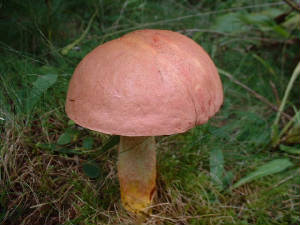
|
| Tylopilus chromapes,Chrome footed Bolete. |
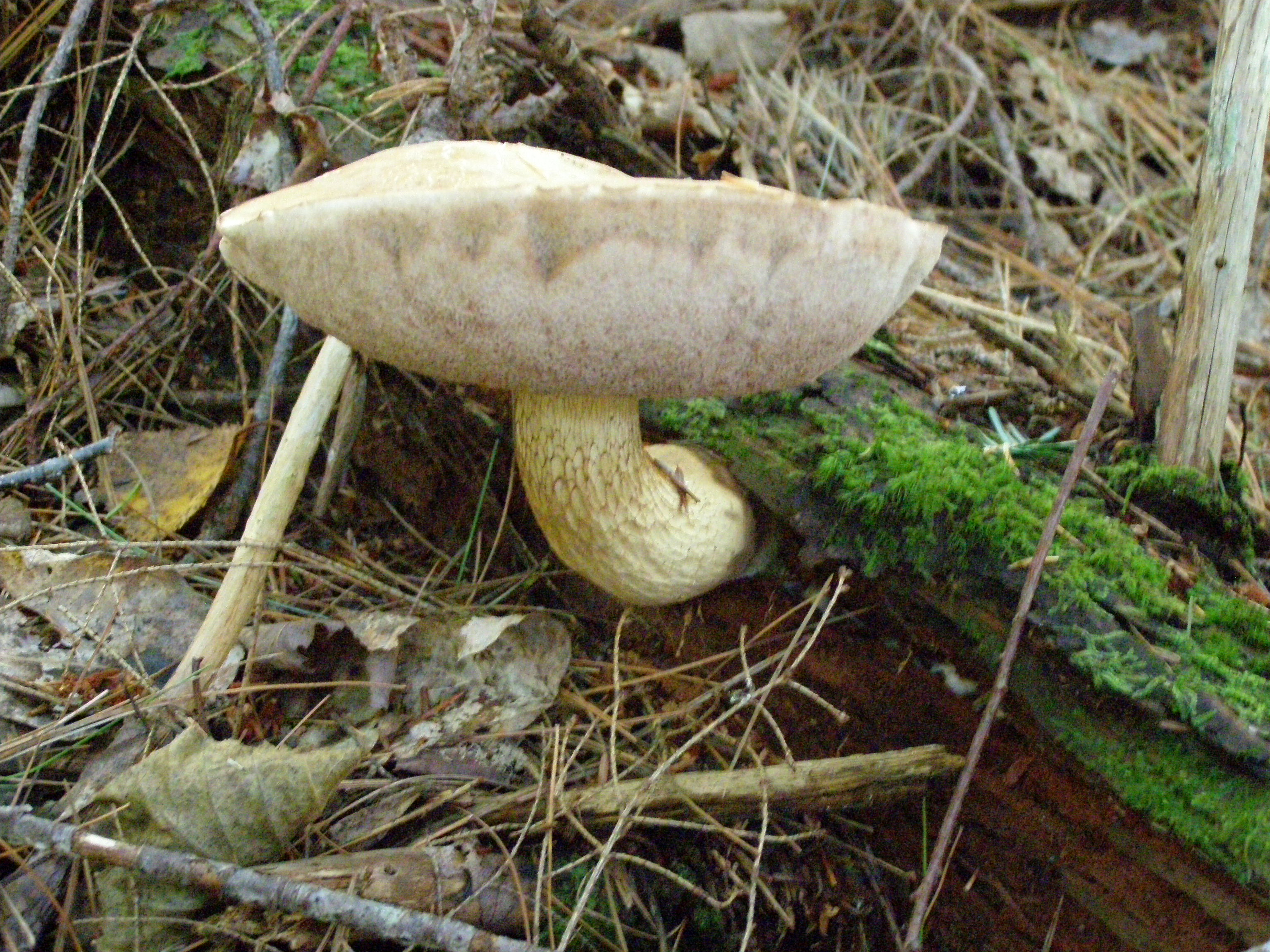
|
| Tylopilus felleus. |
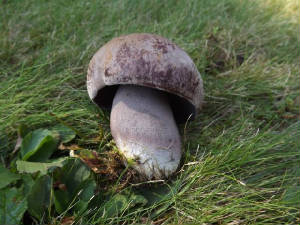
|
| Tylopilus eximius. |
|
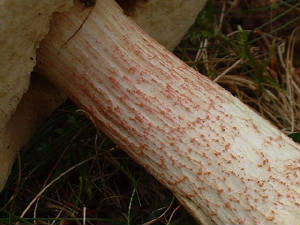
|
| Tylopilus chromapes, Chrome footed Bolete. |
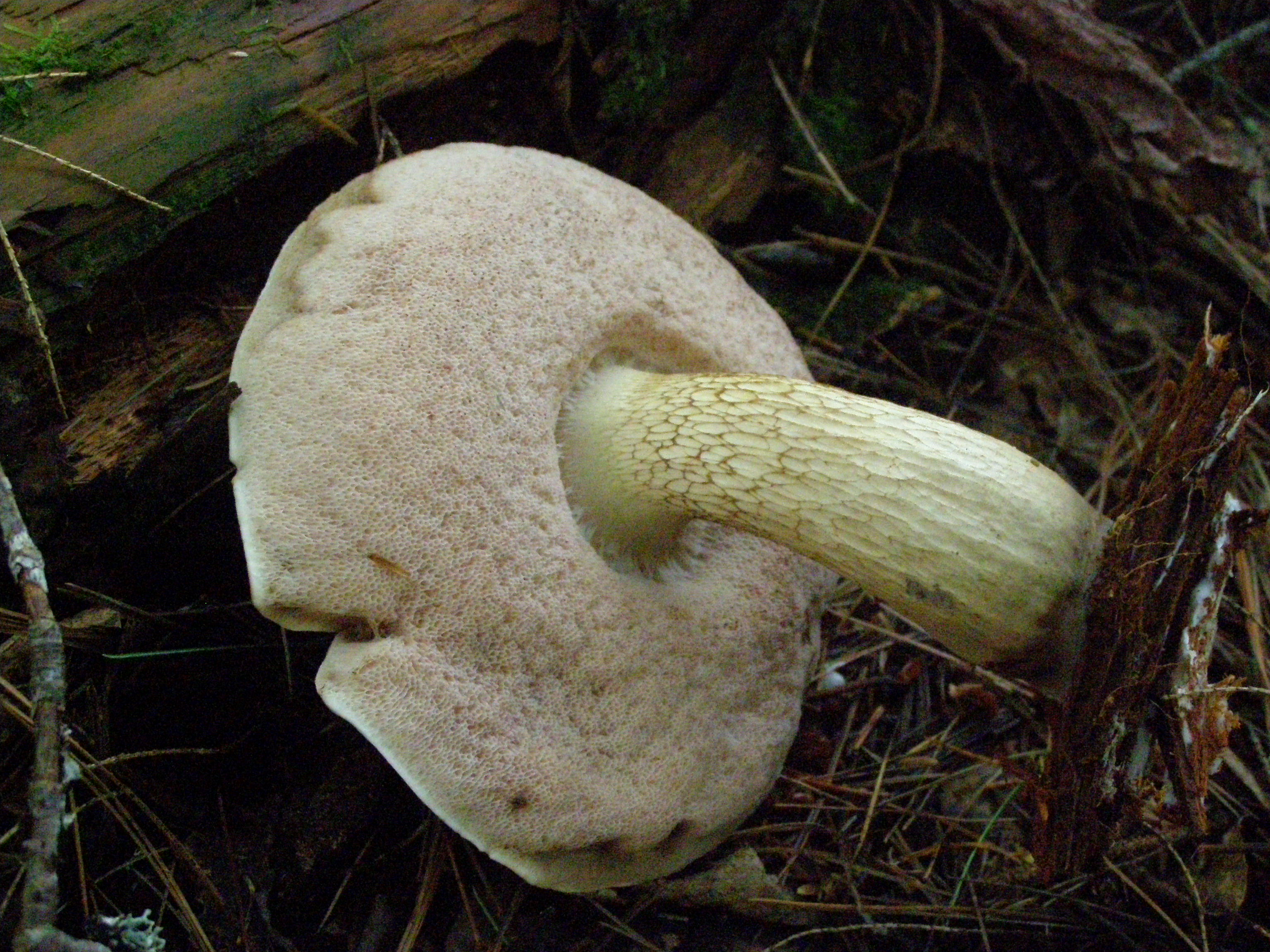
|
| Tylopilus felleus. |

|
| Tylopilus eximius. |
|
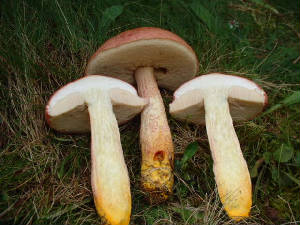
|
| Tylopilus chromapes, Chrome footed Bolete. |
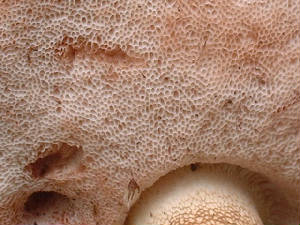
|
| Tylopilus felleus. |
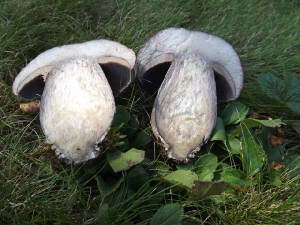
|
| Tylopilus eximius. |
|
| |
|
|
| |
|
|
Xanthoconium.
This is a small genus consisting of only eight species in North America. It's possible that you may come across
five of those eight in our region. Xanthoconium was separated out from Boletus because of it's yellow spore print.
Xanthoconium affine var maculosus, below, was formerly known as Boletus affinis var maculosus.
|
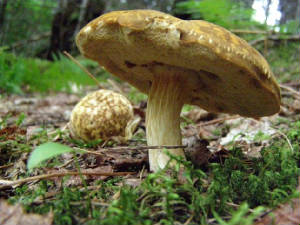
|
| Xanthoconium affine var maculosus.Spotted Bolete. |
|
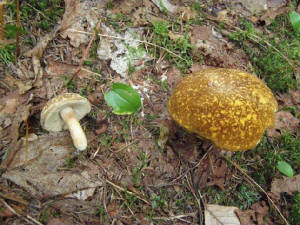
|
| Xanthoconium affine var maculosus.Spotted Bolete. |
|
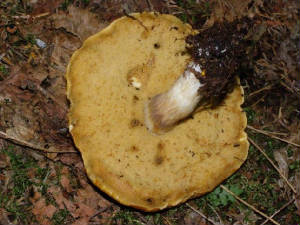
|
| Xanthoconium affine var maculosus.Spotted Bolete. |
|
Austroboletus.
There are only a handful of species that are known in this genera. I have never personally come across any species in
this genus and the only one that you may come across is A.gracilis which is also known as Tylopilus gracilis.
Fuscoboletinus.
This is another small genus with only nine species known in North America. I can find mention of only five of these
species being found in Nova Scotia. They closely resemble members of the genus Suillus. Personally I have failed to find
any of them, but I list them here for reference purposes, they are; F.glandulous, F.grisellus, F.paluster also known as Suillus
paluster, F.serotinus also known as Suillus serotinus and F.viscidus, which is also known as F.laricinus.
Gyroporus.
This is another genus with only a few species. The distinctive characteristics are a yellow spore print and the stalk
is hollow at least at maturity. It's possible we may have in our region as many as four species of the dozen known species
that occur in |North America. I can find mention of only two that are known from Nova Scotia; they are G. cyanescens
and G. castaneus.
Phylloporus.
Only six species are known and the only one that you may run across is P.rhodoxanthus. This species is commonly called
the gilled bolete. I have failed to find this unusual bolete. Spore print deposits are yellow to olive-brown.
Strobilomyces.
This is another small genus with only three species known from North America. The only one you may find is S. floccopus
which is also known as S. strobilaceous. The common name for this rather odd looking bolete is Old Man of the Woods.
Spore print is black.
|




